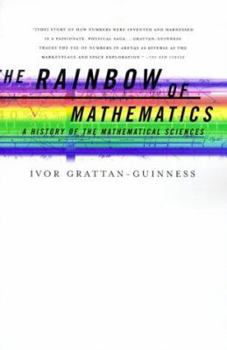The Rainbow of Mathematics: A History of the Mathematical Sciences
Select Format
Select Condition 
Book Overview
He charts the growth of mathematics through its refinement by ancient Greeks and then medieval Arabs, to its systematic development by Europeans from the Middle Ages to the early twentieth century. This book describes the evolution of arithmetic and geometry, trigonometry and algebra; the interplay between mathematics, physics, and mathematical astronomy; and new branches such as probability and statistics. Authoritative and comprehensive, The Rainbow of Mathematics is a unique account of the development of the science that is at the heart of so many other sciences. Originally published under the title The Norton History of the Mathematical Sciences.
Format:Paperback
Language:English
ISBN:0393320308
ISBN13:9780393320305
Release Date:May 2000
Publisher:W. W. Norton & Company
Length:830 Pages
Weight:2.09 lbs.
Dimensions:2.1" x 6.1" x 9.2"
Related Subjects
Math Mathematics Physics Science Science & Math Science & Scientists Science & TechnologyCustomer Reviews
5 ratings
Great general reference for history of math (physical science emphasis)
Published by Thriftbooks.com User , 18 years ago
I bought the book to improve my knowledge of the history of mathematics. I'm a High School math teacher, although I never took a history of math course (lots of history which I generally enjoy). Although a significant portion of the math is beyond the High School curriculum, with the density of over 750 pages there are plenty of anecdotes that can be incorporated and interesting to share. A dense book which covers numerous topics. I've successfully used parts of the book as a personal reference when studying other topics in detail in other books. Referencing this history's summaries on occasion has helped me see the forest through the trees, so to speak. Sometimes this book's summaries of a topic help place a field of mathematics (or a problem within mathematics) in the right context. That said, despite the smallish print and length of the text, the coverage is so wide it's not really going to teach topics in depth as some sort of replacement textbook. Like any good history, there are many fascinating personalities or shall I say "characters" present in the history of math. Pettiness can be found in any field and some of the mathematician's stories and personal conflicts can be pretty silly in retrospect. Final observation - while of course one does not need to be a physicist or mathematician to enjoy large parts of the book, one should at least have some calculus. For those looking for a more basic history of the development of algebra and geometry only, look elsewhere. As others noted there's a strong emphasis with physical science mathematics here which can be either fascinating or overwhelming.
A Must-Read for Mathematicians, Scientists, and Engineers
Published by Thriftbooks.com User , 19 years ago
This magnificent work covers mathematics from its recorded beginnings to the end of World War I. It provides remarkable insight into the development of the various branches of mathematics, and into the connections between mathematical and scientific ideas. Readers will find a wealth of interesting and useful information, including a superb bibliography. Highly recommended!
A Magnificent Account of the History of Mathematics
Published by Thriftbooks.com User , 19 years ago
This milestone in the history of mathematics-history covers mathematics from its recorded beginnings to the end of World War I. It is a synthesis of remarkable historical and mathematical scope. Professor Grattan-Guinness has established a new paradigm of excellence in the field of mathematics-history.
A Brilliant Rainbow
Published by Thriftbooks.com User , 19 years ago
This much-needed book provides valuable insights into the history of the mathematical sciences. Readers will find a wealth of interesting and useful information, including an excellent bibliography. Highly recommended!
An up-to-date, bring-your-own-math history of mathematics
Published by Thriftbooks.com User , 20 years ago
In his introduction, Grattan-Guinness makes several good points about what a history of mathematics should contain. In particular he emphasises "the importance of applications to the physical world", setting his book apart from many other histories that follow the "unfortunate attitude" of "snobbery with regard to pure as opposed to applied mathematics". Partly but not entirely as a result of this approach, Grattan-Guinness covers an enormous amount of material. You are likely to find one or two pages of nontechnical, to-the-point discussion on almost any topic you can think of. This is of course valuable, but it also means that nothing is explained in detail and the book is too fragmented to be very enjoyable as a narrative. As a reference, it complements a history such as Kline's Mathematical Thought in that Grattan-Guinness doesn't bother giving detailed references to very many original works, but instead is strong on modern scholarly interpretations of history and provides lots of references to historical research.





